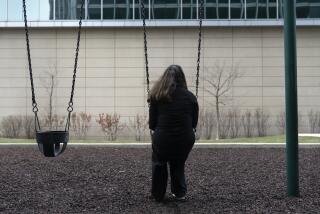Health : Probing the State of Our Minds : Major Study of Mental Illness Finds It Surprisingly Common
- Share via
Almost a third of all Americans suffer from acute mental illness during their lifetime and, at any one moment, major mental disorders afflict almost 15% of the nation’s population, according to new findings from the largest study of its kind ever conducted.
The proportions of mental illness, contained in new projections from the study sponsored by the federal government’s National Institute of Mental Health, significantly exceed many earlier estimates and conflict with assumptions made about them by public-policy officials.
For instance, nationwide rates of obsessive-compulsive disorder, in which sufferers engage in endless repetitive behavior such as washing themselves or checking to see if the stove is turned off, have turned out to be 25 to 60 times greater than previously thought. Instead of being rare, the disease is commonplace.
People Find Ways to Cope
The newly calculated rates also suggest, experts familiar with the study say, that huge--though unmeasured--proportions of people with such disorders as acute schizophrenia, debilitating phobias and major depression simply find ways to cope with their symptoms and live their lives as best they can, never coming in contact with mental health workers.
“We had no idea of the level of phobic conditions and of anxiety disorders. This has been a real eye-opener,” said Dr. Darrel Regier, the NIMH director of the study, which is to be published today.
For instance, in some patients with major fear disorders, speculated Regier, people who are unable to bring themselves to drive across high bridges may simply find alternate routes to work. They live with their illnesses instead of seeking treatment either because they choose to, because treatment resources are financially out of reach or because they are too ill to realize how to get help.
“Somehow, they are able to work around it,” Regier said. “They just don’t go on trains (for instance). They cordon off certain areas of their lives where they can’t function.”
The ordeals such individuals face in their daily lives are often completely unappreciated by even their close friends, said Dr. Daniel X. Freedman, the UCLA-based editor of the journal Archives of General Psychiatry, which is publishing the findings. “These people are walking up a much steeper gradient to accomplish what they can accomplish than the general population,” Freedman said in an interview.
“It’s a hard thing to appreciate. You can understand an amputee having a little trouble walking, but if there are just joint disorders, (the problem may be ignored or misunderstood). Well, there are a lot of creaky psychological joints here that are hurting.”
In addition, according to Regier, the findings suggest that at least some old people who are presumed to be afflicted by irreversible dementias like Alzheimer’s disease may simply be depressed and that they could respond to drugs and other therapy--if only treatment were attempted.
The new observations represent the final conclusions of a $20 million NIMH study originally commissioned in 1980. The study, in which more than 18,500 people selected at random underwent detailed diagnostic interviews, first made headlines four years ago when preliminary results--from interviews in just three of five cities where data were gathered--implied that almost 20% of Americans suffered from serious mental disorders during any six-month period.
The research project is officially called the NIMH Epidemiologic Catchment Area study, meaning that it relies on interviews in catchment areas--standardized, carefully predetermined geographic areas within the five cities involved. Mental health services are organized around a nationwide system of local catchment areas.
To arrive at national rate projections for the 13 disorders involved, a complex statistical manipulation was used that took into account interview samples in rural and urban settings and among a variety of ethnic groups. The new rates were based on a more extensive and sophisticated statistical methodology than the estimates released four years ago.
In the new findings, the final data--from which statistically complex national projections were made for 13 different categories of mental disease--indicate the six-month illness rate is even higher than was previously reported--19.8%, or more than one full percentage point higher than 1984 preliminary figures. The new estimates of prevalence of mental diseases at any given moment were based on the proportion of subjects who had symptoms within 30 days before they were interviewed. Because positive diagnosis often requires symptoms to have persisted for at least two weeks, the 30-day interval was equated with disease existing at any given time.
Overall, the study found 32.2% of Americans have one or more serious mental diseases during their lifetime. Among the study’s other major conclusions are these:
-- Drug abuse, including alcoholism and dependence on other chemicals, is the most common psychiatric problem, and can be expected to strike 16.4% of all adults over 18 at some time during their lives. Alcohol abuse is overwhelmingly more common than abuse of all other drugs combined, with 13.3% of Americans likely to have alcoholic problems during their lives, but only 5.9% likely to misuse other drugs. The percentages add up to more than the total for the category because some victims misuse both alcohol and other substances.
Substance-abuse disorders affect 3.8% of the population at any given point in time. Men are far more likely to be alcohol and drug abusers than women, with 6.3% afflicted at any one time versus 1.6% of women. More than 9% of men 18 to 25 are drug or alcohol abusers at any one moment.
-- Anxiety disorders, including phobias, panic disorder and obsessive-compulsive disorder together make up the second most common form of mental illness, affecting 14.6% of Americans during the course of their lives and 7.3% at any one time. Anxiety disorders are more common in women than in men, with women 18 to 44 most affected. Almost 12% of women 25 to 44 will have severe anxiety disorder symptoms sometime during their lives. Freedman said additional analysis reported at a recent Harvard Medical School conference implied that phobias may be especially prevalent among the poor.
Obsessive-compulsive disorder may affect 2.5% of all Americans at some time during their lives and more than one in 100 at any given point in time.
-- Severe impairment of intellect is quite uncommon below age 65 but increases in incidence rapidly thereafter. However, Regier speculated this gross finding may be seriously misleading--at least for the elderly under 85. He said researchers believe a significant proportion of apparent intellectual collapse in such old people may actually involve depression and not deterioration of the brain.
“If you have a dementia, the only way to find out (if it is depression) is to treat it as depression,” Regier said, “and see if it disappears. It is the kind of thing we don’t have a good estimate of, but it is clear that a certain proportion of people will come in with what looks like dementia but can be treated with an antidepressant. For those who have this condition, the results can be very dramatic.”
-- Over age 85, intellectual deterioration--called “severe cognitive impairment”--increases almost exponentially, with almost 16% of men and women affected. The rates by sex are unbalanced--far higher for women than for men. But researchers believe the difference may be explained by the longer average life-spans of women.
-- Affective disorders--those involving depression--can be expected to affect 8.3% of Americans during their lives and 5.1% at any given moment. Major depressive episodes and chronic, underlying depression are both common. Rates are higher in women, especially those 25 to 64.
-- Schizophrenia--both transient and long-term--is comparatively rare, affecting only 1.5% of all Americans during their lives and fewer than 1% at any point in time. Women exhibit a slight clustering of risk between ages 18 to 44, with a sharp drop-off beyond that age.
Rates for individual diseases total to more than the overall rate for mental illness in general because many people suffer from more than one disease. A person with major depression, for instance, may also abuse drugs.
Data for the study were gathered in interviews in Los Angeles, New Haven, Baltimore, St. Louis and Durham, N.C. The composition of interview groups was different in each city, however, so the study makes no comparisons of regional mental illness rates. In Los Angeles, for instance, a special bilingual interview was used to reach 3,131 subjects, most of whom were Latinos in East Los Angeles, Monterey Park and Montebello. It was the only one of the five cities in which a special effort was made to reach Spanish-speaking subjects.
The Los Angeles research, conducted by UCLA, also surveyed Anglos in Culver City, Mar Vista and Palms. The UCLA team, headed by Dr. Marvin Karno, was also responsible for the analysis that discovered the vastly higher than expected rate of obsessive-compulsive disorder.
Freedman said separate analyses of the data by other researchers have indicated obsessive-compulsives have an unrecognized elevated divorce and separation rate. He said the finding may indicate that many untreated victims unnecessarily undergo loss of their closest personal relationships as a result of their disease.
Karno characterized the discoveries about obsessive-compulsive disorder as a “major surprise.” But he said the failure to realize the true extent of the disease in the population at large may be part of the larger issue of the unrecognized extent of mental illness caused by the failure of many victims to seek treatment.
“This was thought to be a rare disorder,” said Karno of obsessive-compulsive disease. “It turns out it is quite common.
“What we found is that the frequency of many disorders is much higher than anticipated because a very high proportion of people who suffer from them never come in for treatment. They cope with it. They suffer from it.
“We’re not talking about people with just worries and unhappiness. These are major disorders, for most of which very effective treatment is now available.”
Karno contended that a major lesson of the study is that mental health services, which have historically been less available in general and subject to lower reimbursement rates by private insurance plans than strictly physical disorders, are even more essential than had previously been thought.
“Most of these people have no realistic access (to care) because they have no means to afford it,” Karno said. “It’s kind of a cruel paradox as we discover more precisely the scope of disorder. The news provided by these data unfortunately only adds to the burden of unhappiness for people who have worked in the public sector (where mental health programs have been seriously cut in recent years).
“Mental health care is increasingly becoming an opportunity only for the affluent.”
MENTAL HEALTH FINDINGS
--Nearly a third of all Americans can be expected to have an acute mental illness, ranging from schizophrenia and depression to drug abuse, during their lifetimes.
--At any given moment, about a sixth of the population is afflicted with one of 13 major mental illnesses.
--Alcohol and drug abuse are the most common mental health problem, followed by anxiety disorders such as phobias and panic syndromes.
--Some disorders previously thought to be rare are not. Obsessive-compulsive disorder, for instance, is 25 to 60 times more common than previously believed.
--Many elderly people thought to suffer from Alzheimer’s disease and other types of dementia may simply have treatable depression.






